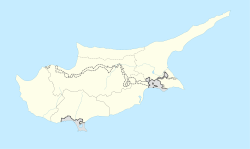Chytri
Χύτροι | |
 Map showing the ancient city Kingdoms of Cyprus | |
| Location | Cyprus |
|---|---|
| Region | Nicosia District |
| Coordinates | 35°15′07″N 33°29′41″E / 35.251979°N 33.494769°E |
Chytri (or Khytri, Greek: Χύτροι) was one of the ten city-kingdoms of Cyprus in antiquity. It was located in the centre of the island, in the territory of Chytraea, west of Mesaoria. Today the modern town of Kythrea (Kyrka) has preserved the ancient name.
Ancient history
[edit]According to mythology, after the fall of Troy, Greek immigrants led by Chytros, son of Alexander and grandson of the Athenian Acamas,[1] hero of the Attic tribe of the same name, settled in Cyprus. The modern village of Kythrea is situated near the ancient kingdom of Chytroi which was founded by Chytros. A necropolis has been discovered. In the time of the Assyrian king Assurbanipal, Pilagura was King of Kitrusi, one of the ten kingdoms on the island. Numerous inscriptions have been found in the Cypriot dialect, some in ordinary Greek. Chytri was noted for the worship of Apollo, Artemis and Aphrodite Paphia. In Delphic Theorodochoi inscription, one inscription mentions Chytri.[2] Later forms of the name are Cythraia, Cythereia, Cythroi, Chytrides; according to the work of Athanasios Sakellarios (Κυπριακά, 1890, 202–205) Kyrka should be Cythera or Cythereia; he identifies Chytri with Palo-Kythro, a village with ruins two hours south of Kyrka.[3][4] However, the historical texts mention only one town.
Diogenes Laërtius writes that there was a festival held at Chytri with theatrical plays.[5]
Middle Ages
[edit]Chytri was at an early date an episcopal see. Lequien's list of the bishops of the see (II, 1069) is very incomplete, only eight being recorded: the first is St. Pappus, who suffered martyrdom under Licinius, Maximinus or Constantius Chlorus; the most famous is St. Demetrian, 885-912 (?).
The Greek, i.e. Orthodox, see of similar title was suppressed in 1222 by Cardinal Pelagius, the papal legate,[6] while the islands was a Latin crusader kingdom.
See also
[edit]References
[edit]- ^ Stephanus of Byzantium, Ethnica, Ch698.9
- ^ Delphic Theorodochoi Inscription
- ^ Pétridès, S. "The Catholic Encyclopedia". newadvent.org. Robert Appleton Company. Retrieved 26 November 2021.
- ^ Sakellarios, Athanasios (1890). "Ta Kypriaka: Toi, Gegraphia, Historia Kai Glssa Ts Nsou Kyprou, Apo TN Archaiotatn Chronon Mechri Smeron". archive.org/. Retrieved 26 November 2021.
- ^ DIOGENES LAERTIUS, LIVES OF THE PHILOSOPHERS, § 3.56
- ^
 Herbermann, Charles, ed. (1913). "Chytri". Catholic Encyclopedia. New York: Robert Appleton Company.
Herbermann, Charles, ed. (1913). "Chytri". Catholic Encyclopedia. New York: Robert Appleton Company.

